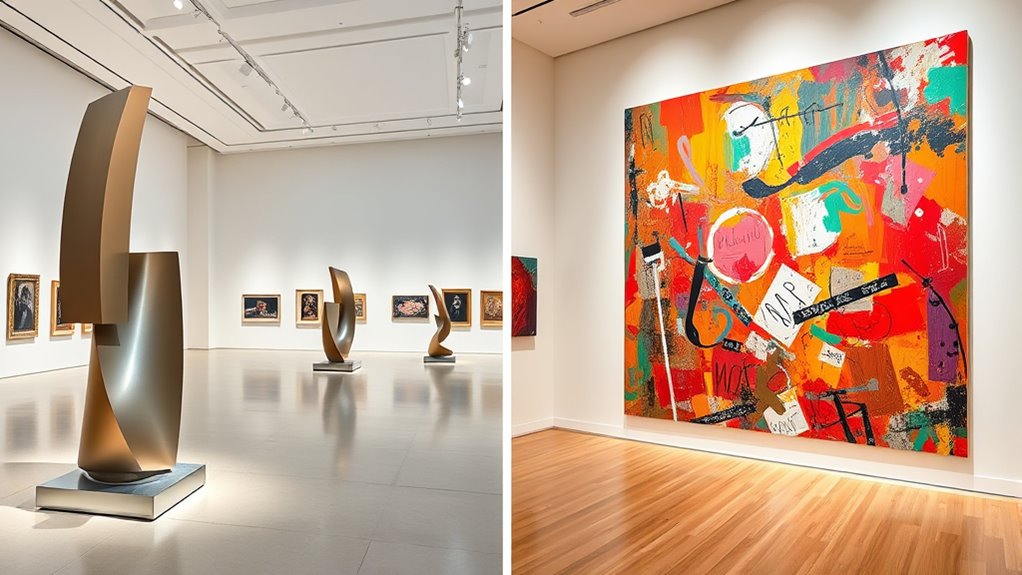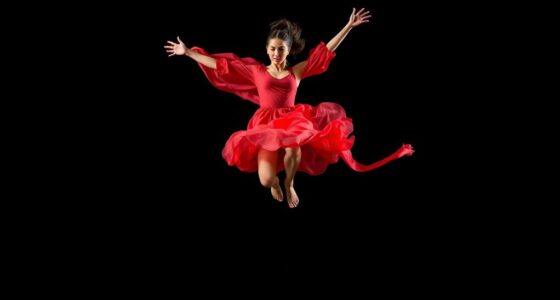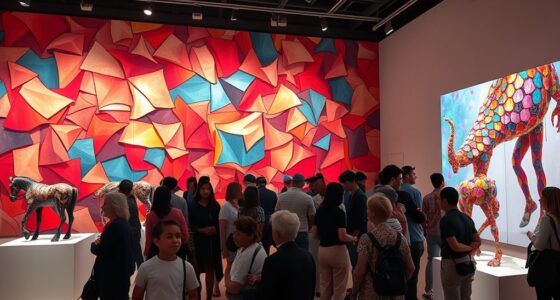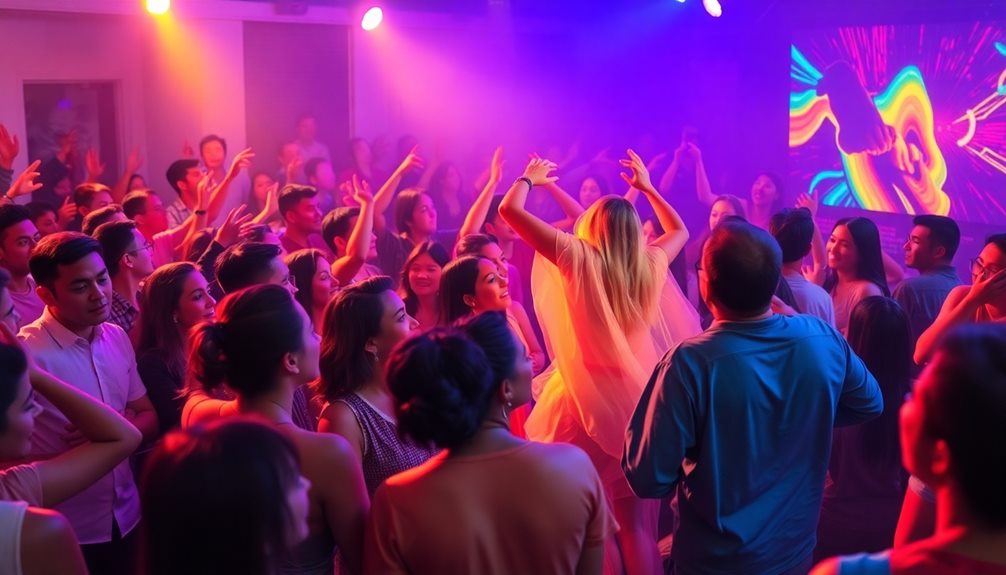Modern and contemporary art are two distinct eras that shape today’s artistic landscape. Modern art, emerging from the late 19th to mid-20th century, focuses on breaking traditional techniques through innovation and abstract expression. In contrast, contemporary art, from the 1960s onward, reflects current societal issues and uses diverse media like digital art and installations. Understanding their differences helps you appreciate how art evolves over time. Keep exploring to uncover the fascinating nuances between these dynamic movements.
Key Takeaways
- Modern art (late 19th to mid-20th century) emphasizes formal experimentation and breaking traditional techniques.
- Contemporary art (1960s-present) reflects current societal issues and often incorporates new media and technology.
- Modern art focuses on emotional expression and abstract forms, while contemporary art explores diverse viewpoints and audience engagement.
- Modern art emerged from post-World War II upheaval, whereas contemporary art responds to globalization and digital advancements.
- Both eras influence ongoing art movements, but modern art laid foundational principles, and contemporary art pushes boundaries further.

Understanding the differences between modern and contemporary art can be confusing, but recognizing their distinct origins and characteristics helps clarify their unique contributions. Modern art, which emerged roughly from the late 19th century to the mid-20th century, was driven by a desire to break away from traditional representational techniques. It introduced bold experimentation, emphasizing innovation and individual expression. Abstract expressionism, a key movement within modern art, exemplifies this shift by focusing on spontaneous, gestural brushstrokes to evoke emotion rather than depict reality. As a cultural influence, this movement reflected the post-World War II era’s upheaval, capturing the chaos, anxiety, and desire for new forms of expression. You might see works that are non-representational, emphasizing the artist’s emotional state over literal depiction, which became a hallmark of modernist innovation. The emphasis on formal innovation in modern art laid the foundation for many later art movements that challenge traditional norms.
In contrast, contemporary art is more fluid, spanning from the 1960s to the present day. It’s characterized by diversity, addressing current social, political, and cultural issues. Contemporary artists often challenge traditional boundaries, blending media and techniques to create provocative pieces. Unlike modern art’s focus on formal innovation, contemporary art emphasizes engagement and dialogue with audiences. Cultural influence remains central here, with artists drawing from a global palette of perspectives. For example, you might encounter works that incorporate digital media, installation art, or performance, reflecting the technological advancements and societal shifts happening now. This era is less about defining a single style and more about exploring multiple viewpoints, making it more inclusive and dynamic.
Understanding these distinctions, you’ll notice that modern art’s emphasis on formal experimentation and emotional expression laid the groundwork for the expansive and socially conscious scope of contemporary art. Modern movements like abstract expressionism sought to express universal human feelings through individual artistic gestures, often influenced by the cultural upheavals of their time. Contemporary art, on the other hand, continues to evolve, addressing issues like identity, globalization, and technology, reflecting the complex cultural landscape of today. Recognizing these differences helps you appreciate how each era’s unique context shaped its art, and how both continue to influence the art world today. Whether you’re admiring a bold abstract piece from the modernist era or engaging with a mixed-media installation from contemporary times, understanding their origins enhances your appreciation of their significance and ongoing dialogue within the art community. Additionally, awareness of artistic innovation helps deepen your understanding of how art evolves over time.
Frequently Asked Questions
How Did Cultural Shifts Influence Modern and Contemporary Art?
You see that cultural influences and societal changes shape modern and contemporary art considerably. As society evolves—embracing new ideas, technologies, and perspectives—you respond by creating art that reflects these shifts. These influences inspire experimentation, challenge traditional norms, and express individual and collective identities. By engaging with cultural influences and societal changes, you help push the boundaries of art, making it a powerful mirror of the world around you.
What Are the Key Differences in Artist Motivations Between the Eras?
Did you know that 65% of modern artists aimed to challenge traditional techniques? In these eras, artist intent focused on innovation, rebellion, or personal expression, driven by societal shifts. Today, contemporary artists prioritize diverse narratives and social commentary, with creative purpose often rooted in activism. Your understanding of these motivations reveals how art evolves—from personal exploration in modern times to broader cultural conversations today.
How Do Art Market Trends Differ for Modern and Contemporary Artworks?
You’ll notice that auction trends for modern artworks often attract seasoned collectors, leading to high prices for iconic pieces. In contrast, contemporary art auctions appeal to a broader, younger demographic, with more experimental works gaining popularity. Collector demographics shift accordingly, influencing market dynamics. As a result, modern art tends to hold steady, while contemporary art experiences rapid growth, reflecting evolving tastes and increased accessibility for new buyers.
In What Ways Do Technological Advancements Impact These Art Periods?
Did you know that over 50% of art sales now happen online? Technological advancements like digital tools and virtual galleries dramatically impact both modern and contemporary art periods. They make art more accessible, allowing you to explore and purchase pieces from anywhere. These innovations also help artists reach wider audiences and experiment with new media, shifting how art is created, shared, and appreciated in today’s digital age.
How Do Audience Perceptions Vary Between Modern and Contemporary Art?
You notice that audience perceptions differ between modern and contemporary art. With modern art, people often focus on the perception of originality and appreciate its groundbreaking qualities. In contrast, contemporary art is more about valuing novelty and current relevance, which can lead to diverse reactions. Your perception of these works shifts based on how much they challenge tradition versus how fresh and innovative they seem in today’s cultural landscape.
Conclusion
Remember, art is always evolving, and understanding its shifts helps you appreciate its true essence. Modern and contemporary art each tell unique stories of their time, reflecting changing ideas and styles. As the saying goes, “The only constant in life is change.” By embracing this, you’ll see how these eras connect and evolve, enriching your appreciation for art’s ongoing journey. Keep exploring, and you’ll discover a world of creativity constantly in motion.









